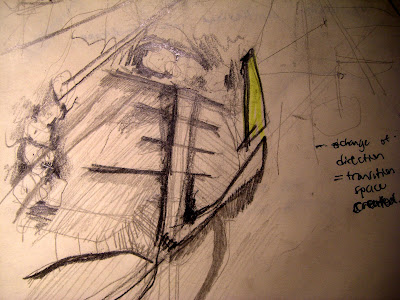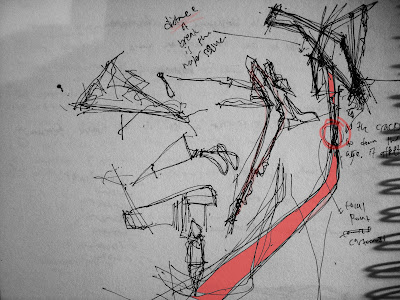
Sunday, December 7, 2008
Saturday, November 8, 2008
Monday, November 3, 2008
Wednesday, October 15, 2008
Monday, October 13, 2008
Thursday, September 11, 2008
Wednesday, September 10, 2008
week 7
after 2 weeks break i am now back, thinking about how the space, precisely, the ' transitional space', as the strongest concept as a whole for the house for michael leunig.
 location plan.
location plan.
site contour. 1: 1000
I would consider this site, the Bruny Island site, having a significant site constrains due to the fragility of the eco systems, and assuming lack of water supply and sewer infrastructure. As the neighbours of the resident is yourself, the woods (eulcapytus) and the water (ocean), it is much an independent / private retreat, where, the purity of the relationship between human + nature is found.
The client :
Michael Leunig. As I was reading through some infos on him, I've found that he's is a man, whom prefer quite,serene countryside lifestyle. Is this the site he wants? I wouldnt know, yet.
I would define as, A change of the direction, a change of view, a change of sense, a change of level.
As we walked through the door, what matters most would be the existance of the transition, which acted as an actual physical place, between inside and outside, change in surfaces which have indirectly, creates the psychological transition in your mind.
The 'unknown', which would be, or would not be appear on the other side of the corner when the movement of body is made, is the transition place, which, serves as the threshold, or also the negative spaces, gives a sense of 'pause', where you need to start thinking of , where to go, what to do to continue going to the other space.
In relation to explain the transition space, I've come up with some diagrams, which i think quite successful in order to make note for acknowledging the transformation of the transitional space.
 1. the union of spaces ( composition of elements)
1. the union of spaces ( composition of elements)
2. dissection of elements which eventually creates a fine line between spaces /(boundary)
3. imaginary spaces is created after dissection. this has lead to formation of 'transition time'
4. these imaginary spaces (which still, maintain as unknown areas), function as the absorber, as the buffer between each functional spaces, while extending the distance and also maximising the travelling time between spaces.
still loads of investigations to be done.
stay tuned.
some sketches.
but, we questioned ourselves, how to define transition space, into an architectural manner, giving a sense of how the house should look like.
I've not really into setting up the brief yet, but have taken some issues into account.
The site :
Bruny Island, Tasmania.
 location plan.
location plan.
site contour. 1: 1000
I would consider this site, the Bruny Island site, having a significant site constrains due to the fragility of the eco systems, and assuming lack of water supply and sewer infrastructure. As the neighbours of the resident is yourself, the woods (eulcapytus) and the water (ocean), it is much an independent / private retreat, where, the purity of the relationship between human + nature is found.
The client :
Michael Leunig. As I was reading through some infos on him, I've found that he's is a man, whom prefer quite,serene countryside lifestyle. Is this the site he wants? I wouldnt know, yet.
back to the topic.
what is transitonal space?I would define as, A change of the direction, a change of view, a change of sense, a change of level.
As we walked through the door, what matters most would be the existance of the transition, which acted as an actual physical place, between inside and outside, change in surfaces which have indirectly, creates the psychological transition in your mind.
The 'unknown', which would be, or would not be appear on the other side of the corner when the movement of body is made, is the transition place, which, serves as the threshold, or also the negative spaces, gives a sense of 'pause', where you need to start thinking of , where to go, what to do to continue going to the other space.
In relation to explain the transition space, I've come up with some diagrams, which i think quite successful in order to make note for acknowledging the transformation of the transitional space.
 1. the union of spaces ( composition of elements)
1. the union of spaces ( composition of elements)2. dissection of elements which eventually creates a fine line between spaces /(boundary)
3. imaginary spaces is created after dissection. this has lead to formation of 'transition time'
4. these imaginary spaces (which still, maintain as unknown areas), function as the absorber, as the buffer between each functional spaces, while extending the distance and also maximising the travelling time between spaces.
still loads of investigations to be done.
stay tuned.
some sketches.




Monday, September 1, 2008
follow ups
i strongly believe the white card has become the main difference to distinguish the start and the end.
more to come.
Thursday, August 28, 2008
item 4 : blending
a divider between reality and imaginary.
open space to an enclosed area, or the other way round, where trust needed to enter the enclosed space.
spatial module + trials
the digital spatial module

the isolated one in the other end, is the final destination.
what do you see along the journey?

trials +1
 trials +2
trials +2
sketches
what will you do when you are walking along the 'corridor'?
what will happened?
chaos? peace? or something unexpected?
every single step made is the beginning of a journey, a new experience.
 the intersection.
the intersection.
do you continue?
stop?
or turn back?
intersection, i would defined as dilemma of the process.
that's where the journey starts.
item
"Here was this little space in the paper, it's like a little stage. I thought it's a little stage and I can put little actors on it and things and why should I restrict this to these boring politicians?"
chaotic situations is not needed here.
Sunday, August 17, 2008
Subscribe to:
Posts (Atom)

































